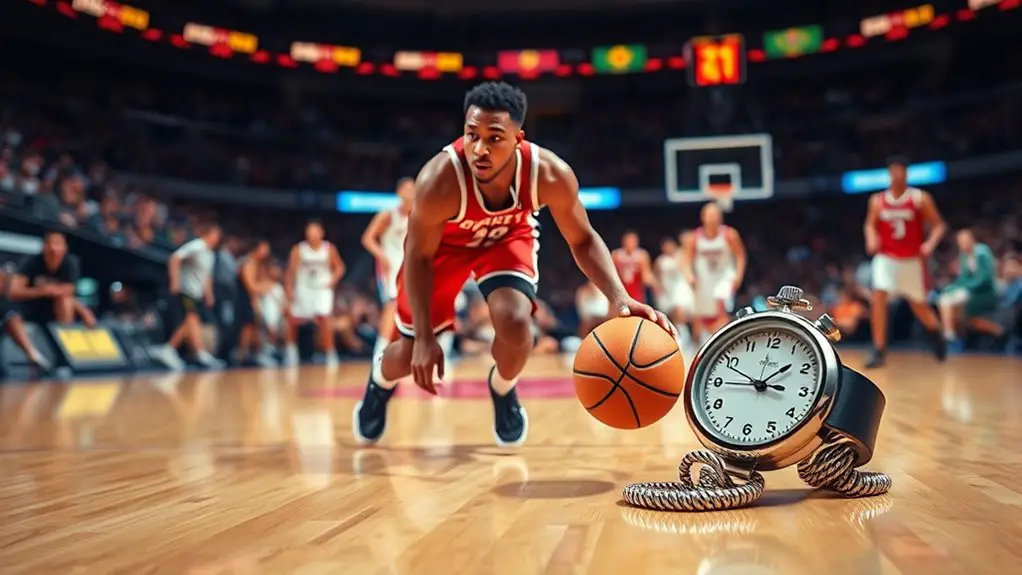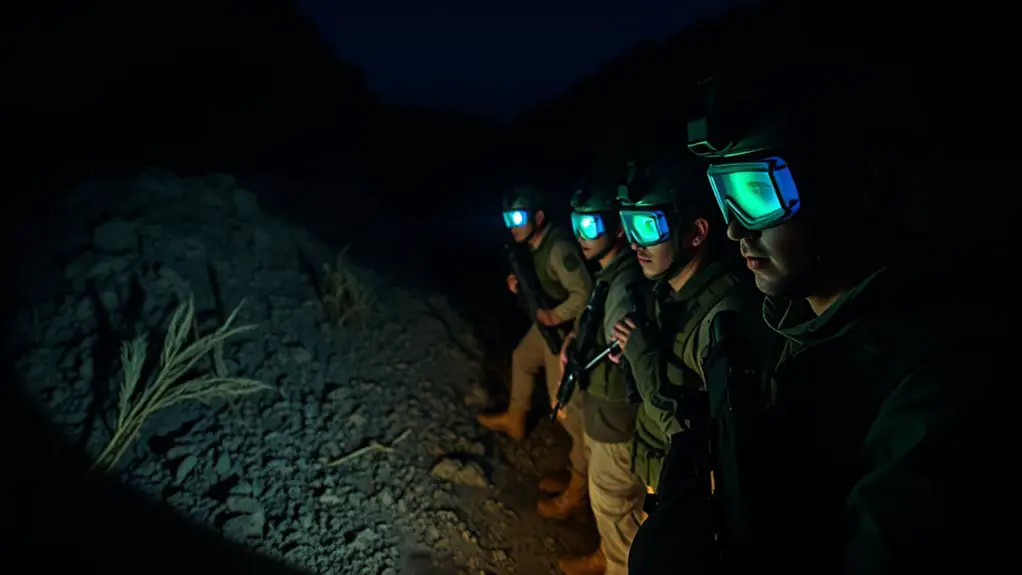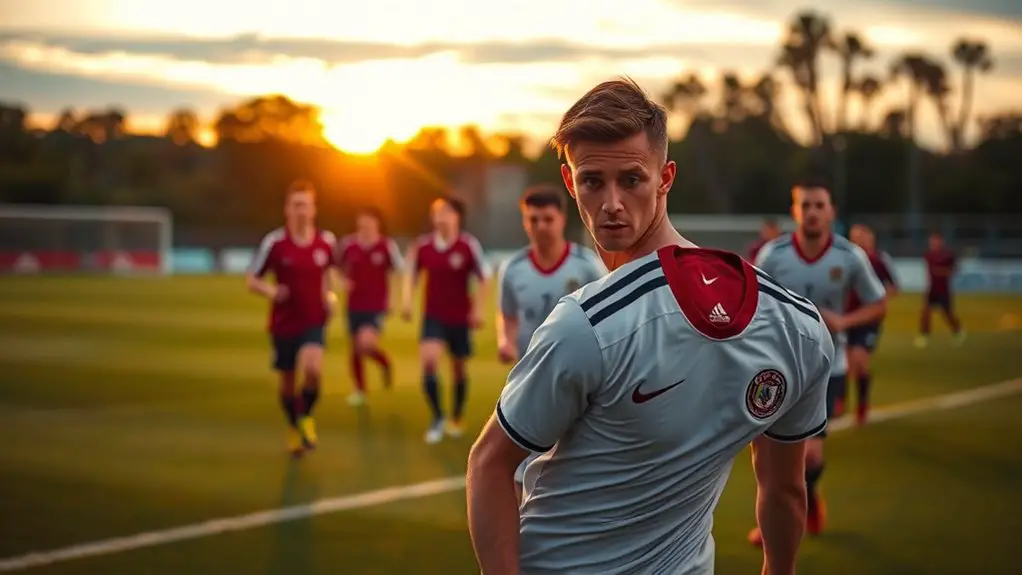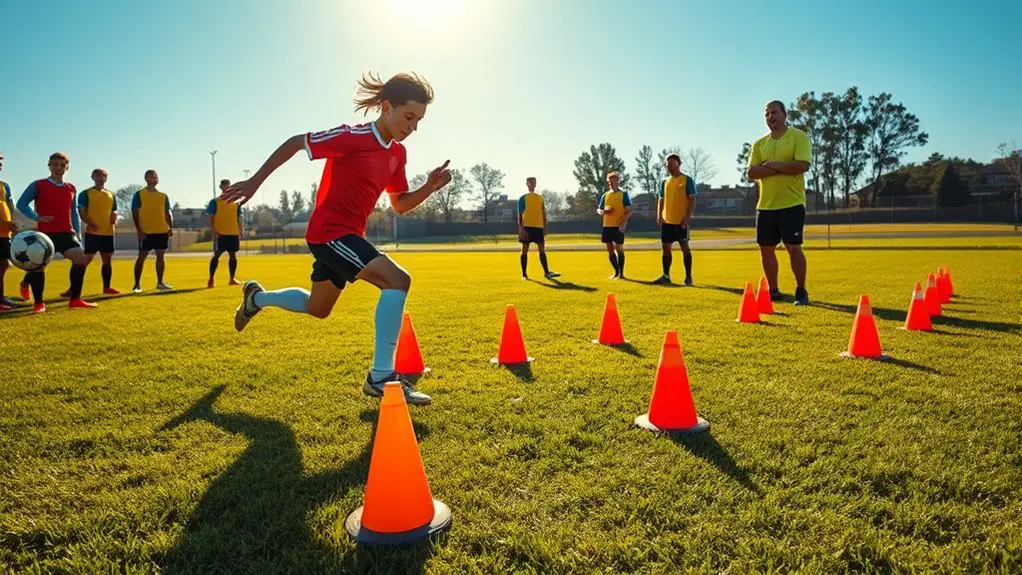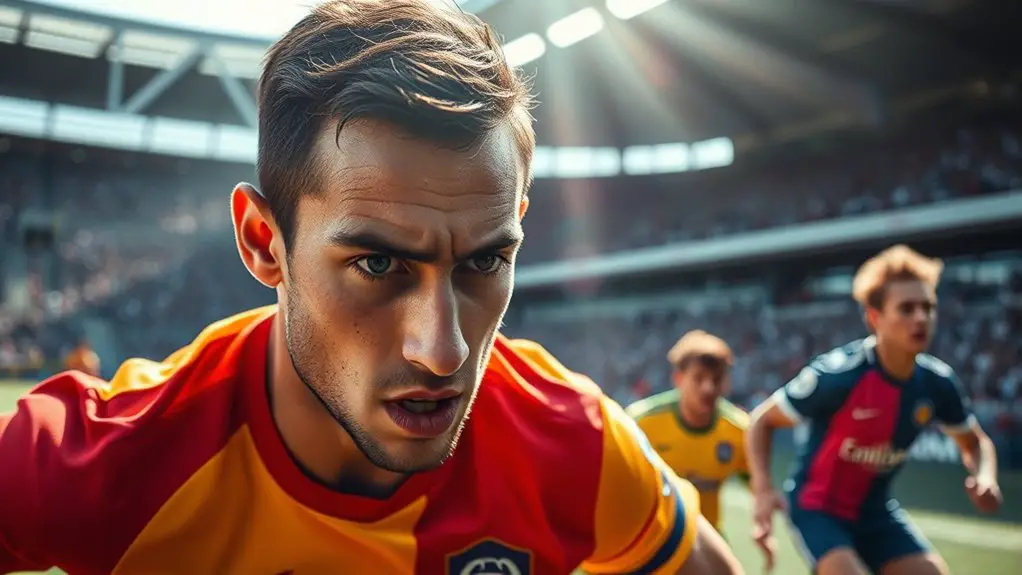To develop better court awareness and reaction time, focus on your positioning and visual skills during gameplay. Enhance your ability to anticipate plays by observing your surroundings and practicing targeted drills. Mindfulness exercises can improve your focus and clarity, while technology like video analysis and wearable devices helps you track your performance. Fostering effective communication with teammates builds trust and teamwork. Keep going, and you'll discover even more strategies to elevate your game.
Understanding Court Awareness
Understanding court awareness is essential for players looking to elevate their game. You've gotta be aware of your surroundings, and that means mastering court positioning. When you know where to stand, you can anticipate the flow of the game better. Think about how your position affects player movement—both yours and your opponents'.
Being in the right spot allows you to make quicker decisions and react effectively to plays. Keep an eye on your teammates and opponents; their movements can provide critical insights into the game's direction.
Practice reading the court as if it's a map, with every player a landmark. This way, you'll not only navigate the space more freely but also create opportunities for yourself and your team. Embrace this sense of freedom on the court, and watch how your game transforms as you become more aware of every movement around you. Additionally, developing your reaction time through specific drills can significantly enhance your ability to respond to dynamic situations on the court.
The Importance of Reaction Time
Court awareness sets the stage for another key skill: reaction time. Your ability to respond quickly can change the game, influencing both your reaction speed and decision making under pressure. When you're aware of your surroundings, you can make snap judgments that lead to successful plays.
| Reaction Speed | Impact on Decision Making |
|---|---|
| Fast | Quick, instinctive choices |
| Moderate | Thoughtful but slower actions |
| Slow | Hesitation leads to missed opportunities |
Improving your reaction time not only helps in executing plays effectively but also gives you the freedom to express your style on the court. By honing this skill, you empower yourself to seize opportunities, dodge opponents, and make those game-changing moves that can turn the tide in your favor. Incorporating visualization techniques can further enhance your responsiveness on the court. So, embrace the challenge and work on sharpening your reaction time!
Visual Training Techniques
To enhance your reaction time and overall performance, incorporating visual training techniques is essential. These methods will not only improve your eye coordination but also sharpen your visual tracking skills, enabling you to respond more effectively on the court. Here are three techniques to get you started:
- Ball Drops: Have a partner drop a ball while you focus on catching it. This enhances your visual tracking and quickens your reflexes.
- Target Focus: Use colored dots or targets placed around your practice area. Shift your gaze quickly between them to improve your eye coordination and peripheral awareness.
- Reaction Balls: Bounce a reaction ball and focus on catching it as it unpredictably changes direction. This trains your eyes to track fast-moving objects, improving your overall agility. Additionally, practicing these techniques can help you develop mental clarity, allowing for swift reactions and better decision-making during games.
Anticipation Drills
While visual training techniques lay the foundation for improved reaction time, anticipation drills take your skills a step further by honing your ability to predict and respond to opponents' movements. Engaging in anticipation exercises helps you develop a keen sense of timing, allowing you to make quicker decisions on the court. Additionally, incorporating agility training techniques into your drills can further enhance your ability to read and react during gameplay.
Here are some effective anticipation drills you can incorporate into your practice:
| Drill Type | Description |
|---|---|
| Shadowing | Mimic an opponent's movements in real-time. |
| Reaction Ball | Use a reaction ball to enhance unpredictability. |
| Game Simulation | Play practice games focusing on reading opponents. |
| Quick-Response Partner | Work with a partner to improve decision-making speed. |
| Visual Cue Training | Respond to visual signals to enhance anticipation. |
Developing Spatial Awareness
As you enhance your skills on the court, developing spatial awareness becomes essential for improving your overall performance. When you grasp your surroundings, you'll react more intuitively. Here are three key strategies to boost your spatial awareness:
- Engage in Spatial Mapping: Visualize the court's layout and your position relative to opponents and teammates. This mental map helps you anticipate plays and movements.
- Utilize Environmental Cues: Pay attention to the sounds, movements, and even the crowd's energy. These cues can guide your decisions and reactions.
- Practice Dynamic Drills: Incorporate drills that require you to move while maintaining awareness of other players and the ball. This helps you develop a sense of space in real-time situations. Additionally, visualization can enhance muscle memory and coordination, further improving your response time on the court.
Mindfulness and Focus Exercises
To enhance your court awareness and reaction time, incorporating mindfulness and focus exercises is key. Breathing techniques can help ground you in the moment, while visualization practices can sharpen your mental clarity. Together, these methods can elevate your performance on the court. Additionally, enhanced focus through mindfulness allows for quick, instinctive decisions under pressure, further improving your game.
Breathing Techniques
Breathing techniques can play an essential role in enhancing mindfulness and focus during court activities. By mastering breath control, you can tap into relaxation techniques that promote clarity. Here are three effective methods to integrate into your practice:
- Deep Breathing: Inhale deeply through your nose, expanding your diaphragm, then exhale slowly through your mouth. This helps ground you and reduces tension.
- Box Breathing: Inhale for a count of four, hold for four, exhale for four, and pause for four. This rhythmic pattern fosters concentration and calmness.
- Focused Breathing: Concentrate on your breath as it flows in and out. Whenever distractions arise, gently bring your awareness back to your breathing.
Visualization Practices
While engaging in court activities, visualization practices can greatly enhance your mindfulness and focus. You can use various visualization methods to create mental imagery that sharpens your awareness of the court environment. Picture yourself maneuvering through the court, anticipating plays, and responding seamlessly to opponents. This mental rehearsal not only improves your reaction time but also boosts your confidence.
Set aside a few minutes daily to visualize different game scenarios, imagining how you'd react to each one. Embrace the freedom that comes with this practice, allowing your mind to explore possibilities without limits. The more vivid and detailed your mental imagery, the more effective these exercises will be. Commit to this journey, and watch your court awareness transform.
Utilizing Technology for Improvement
As athletes seek to enhance their court awareness and reaction time, technology offers innovative tools that can make a significant difference. Here are three key ways to leverage tech for improvement:
- Video Analysis: Use video analysis to review your performance. It helps you see your movements and decisions in real-time, providing valuable insights for improvement.
- Wearable Technology: Incorporate wearable technology to monitor your physical metrics. These devices can track your heart rate, speed, and even reaction times, helping you identify areas to enhance.
- Virtual Reality and Mobile Apps: Engage with virtual reality and mobile apps designed for interactive coaching. These platforms simulate game situations, allowing you to practice reaction times and decision-making in a controlled environment, which can enhance mental resilience and focus under pressure.
Incorporating Team Play and Communication
To enhance court awareness and reaction time, incorporating team play and effective communication is essential. When you're on the court, it's not just about individual skills; it's about fostering team synergy. You need to be aware of where your teammates are and how they're moving. By maintaining open lines of communication, you can anticipate plays and react faster.
Use verbal cues and non-verbal signals to let your teammates know your intentions. This not only builds trust but also sharpens your collective instincts. When everyone's on the same page, you'll find that reactions become almost instinctual, allowing your team to flow seamlessly during the game. Additionally, fostering a strong support system among teammates can significantly enhance motivation and overall performance.
Frequently Asked Questions
How Can Diet Impact Court Awareness and Reaction Time?
Your diet plays an essential role in your cognitive performance, directly influencing your court awareness and reaction time. By adopting effective nutrition strategies, you can fuel your brain and body for peak performance. Foods rich in omega-3 fatty acids, antioxidants, and complex carbohydrates can enhance mental clarity and focus. When you prioritize balanced meals, you'll notice improved alertness and quicker reflexes, giving you the freedom to react instinctively during the game.
What Role Does Physical Fitness Play in Improving Reaction Time?
Physical fitness plays an essential role in improving your reaction time. By incorporating strength training into your routine, you build the muscle power needed to respond quickly. Agility drills enhance your coordination and footwork, allowing you to move swiftly on the court. When you focus on these aspects, you'll notice a significant boost in your overall performance. So, get moving and embrace the freedom that comes with being fit and quick!
How Often Should I Practice These Skills?
You'd think practicing these skills once in a while would be enough, right? Wrong! To really improve, you should engage in daily drills and skill assessments. Consistency is key, so carve out time each day to focus on your reaction time and court awareness. It might feel like a chore at first, but the freedom you'll gain on the court will make it all worthwhile. Trust me, your future self will thank you!
Can Age Affect Court Awareness and Reaction Time?
Yes, age can definitely affect court awareness and reaction time. As you age, cognitive aging may slow your processing speed and decision-making abilities. In contrast, youth development often allows younger players to react more quickly and absorb information faster. While you can still sharpen your skills at any age, it is crucial to recognize these changes and adapt your training methods to maintain that sense of freedom and agility on the court.
Are There Specific Sports That Require Better Court Awareness?
Think of court awareness as the conductor of an orchestra; every player and movement creates a symphony. In sports like basketball, strategy hinges on quick decisions and spatial awareness, while in tennis, positioning can make or break a match. You've gotta know where everyone is and predict their next move. Engaging in these sports not only sharpens your skills but also gives you that exhilarating sense of freedom on the court.
